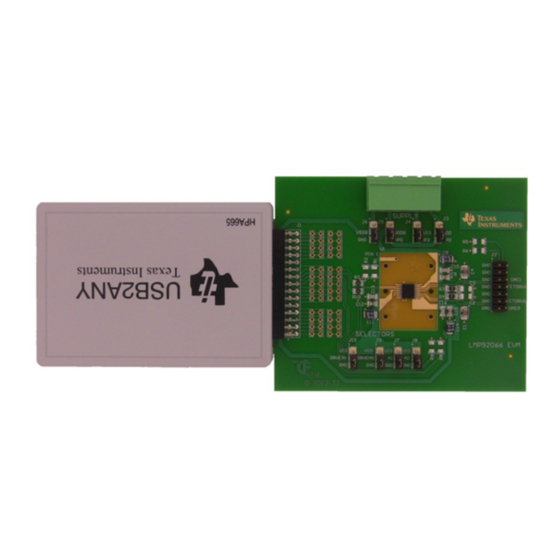
Summary of Contents for Texas Instruments LMP92066
- Page 1 Using the LMP92066 Evaluation Module User's Guide Literature Number: SNAU153 MARCH 2014...
-
Page 2: Table Of Contents
Contents ......................... Quick Start ..................... Software Installation ......................Kit Assembly ......................Software Startup ..................vs Temperature Sweep DACx ......................... Schematic Table of Contents SNAU153 – MARCH 2014 Submit Documentation Feedback Copyright © 2014, Texas Instruments Incorporated... - Page 3 64-bit environments. Evaluation Module – LMP92066EVM The LMP92066EVM is a connectivity board: provisions are made for ease of interfacing LMP92066 to the lab test equipment and the I C bus controller. The only active device on the board is the LMP92066 device.
- Page 4 USB2Any is provided as either enclosed or unenclosed unit. The LMP92066EVM plugs in directly to USB2Any. For in-system evaluation of the LMP92066, a ribbon cable is provided for connecting of USB2Any to a target system equipped with a suitable header.
-
Page 5: Quick Start
Quick Start Software Installation To install the LMP92066 EVM GUI, run the setup.exe, a self-extracting archive that will install all the necessary components of the user application – this includes the LabView run-time environment. The setup.exe will also install Python 2.7, if it is not already present in the target system. -
Page 6: Software Startup
Figure 3. Software Startup The application program can be invoked through the START menu: look for LMP92066 EVM GUI in ‘All Programs’ tab. Alternatively, the executable can be found in the installation directory – default is C:/Program Files(86)/Texas Instruments/LMP92066 EVM GUI/LMP92066 EVM GUI.exe GUI –... - Page 7 “Low Level Configuration” the following page will be shown. Figure 5. The “Low Level Configuration” page gives direct access to the internal registers of the LMP92066. Selecting a line in the “Register Map” will bring up the “Register Data” set of controls, which lets the user set and un-set the individual bit fields.
- Page 8 Figure 6. This page gives an overview of the current state of the LMP92066. “Read All” button downloads current data from the device and updates the GUI screen. All controls with white background can be modified by the user and sent immediately to the device (left-click on the control, enter new HEX value, and press ENTER).
- Page 9 “OK”, which will both read in the file into the GUI and send the LUT data to the operating memory of LMP92066. At this point the new values of the LUT take effect in the signal path of LMP92066. Note that the EEPROM has not been written with new values, yet (no Burn has been performed). The LUT values can be validated/tested without committing them to EEPROM, through the use of the external text file.
- Page 10 To Burn the EEPROM, that is, to copy the data from the operating memory to the non-volatile memory, press “BURN EEPROM” button. NOTE: At the time of writing this manual, Texas Instruments ensured the performance of the EEPROM for up to 10 write cycles (Burns).
-
Page 11: Vdacx Vs Temperature Sweep
When plot is completed, or when “STOP” is pressed, a text log file is created in the ‘C:/Program Data/Texas Instruments/LMP92066 EVM GUI/Logs/Datalog’ directory. SNAU153 – MARCH 2014 LMP92066 Dual Temperature-Controlled DAC Evaluation Module Submit Documentation Feedback Copyright © 2014, Texas Instruments Incorporated... - Page 12 Quick Start www.ti.com Board Layout SUPPLY LMP92066 LMP92066 EVM J7 J8 Figure 10. LMP92066EVM Board Layout LMP92066 Dual Temperature-Controlled DAC Evaluation Module SNAU153 – MARCH 2014 Submit Documentation Feedback Copyright © 2014, Texas Instruments Incorporated...
- Page 13 [No Variations] Sheet: warrant that this design will meet the specifications, will be suitable for your application or fit for any particular purpose, or will operate in an implementation. Texas Instruments and/or its Drawn By: Not shown in title block File: SV600875A1_2_LMP92066_Circuit.SchDoc...
- Page 14 STANDARD TERMS AND CONDITIONS FOR EVALUATION MODULES Delivery: TI delivers TI evaluation boards, kits, or modules, including any accompanying demonstration software, components, or documentation (collectively, an “EVM” or “EVMs”) to the User (“User”) in accordance with the terms and conditions set forth herein. Acceptance of the EVM is expressly subject to the following terms and conditions.
- Page 15 FCC Interference Statement for Class B EVM devices NOTE: This equipment has been tested and found to comply with the limits for a Class B digital device, pursuant to part 15 of the FCC Rules. These limits are designed to provide reasonable protection against harmful interference in a residential installation.
- Page 16 【無線電波を送信する製品の開発キットをお使いになる際の注意事項】 開発キットの中には技術基準適合証明を受けて いないものがあります。 技術適合証明を受けていないもののご使用に際しては、電波法遵守のため、以下のいずれかの 措置を取っていただく必要がありますのでご注意ください。 1. 電波法施行規則第6条第1項第1号に基づく平成18年3月28日総務省告示第173号で定められた電波暗室等の試験設備でご使用 いただく。 2. 実験局の免許を取得後ご使用いただく。 3. 技術基準適合証明を取得後ご使用いただく。 なお、本製品は、上記の「ご使用にあたっての注意」を譲渡先、移転先に通知しない限り、譲渡、移転できないものとします。 上記を遵守頂けない場合は、電波法の罰則が適用される可能性があることをご留意ください。 日本テキサス・イ ンスツルメンツ株式会社 東京都新宿区西新宿6丁目24番1号 西新宿三井ビル 3.3.3 Notice for EVMs for Power Line Communication: Please see http://www.tij.co.jp/lsds/ti_ja/general/eStore/notice_02.page 電力線搬送波通信についての開発キットをお使いになる際の注意事項については、次のところをご覧くださ い。http://www.tij.co.jp/lsds/ti_ja/general/eStore/notice_02.page SPACER EVM Use Restrictions and Warnings: 4.1 EVMS ARE NOT FOR USE IN FUNCTIONAL SAFETY AND/OR SAFETY CRITICAL EVALUATIONS, INCLUDING BUT NOT LIMITED TO EVALUATIONS OF LIFE SUPPORT APPLICATIONS.
- Page 17 Notwithstanding the foregoing, any judgment may be enforced in any United States or foreign court, and TI may seek injunctive relief in any United States or foreign court. Mailing Address: Texas Instruments, Post Office Box 655303, Dallas, Texas 75265 Copyright © 2015, Texas Instruments Incorporated...
- Page 18 IMPORTANT NOTICE Texas Instruments Incorporated and its subsidiaries (TI) reserve the right to make corrections, enhancements, improvements and other changes to its semiconductor products and services per JESD46, latest issue, and to discontinue any product or service per JESD48, latest issue.










Need help?
Do you have a question about the LMP92066 and is the answer not in the manual?
Questions and answers